The SanDisk X400 1TB SSD Review
by Billy Tallis on May 6, 2016 9:00 AM ESTMixed Random Read/Write Performance
The mixed random I/O benchmark starts with a pure read test and gradually increases the proportion of writes, finishing with pure writes. The queue depth is 3 for the entire test and each subtest lasts for 3 minutes, for a total test duration of 18 minutes. As with the pure random write test, this test is restricted to a 16GB span of the drive, which is empty save for the 16GB test file.
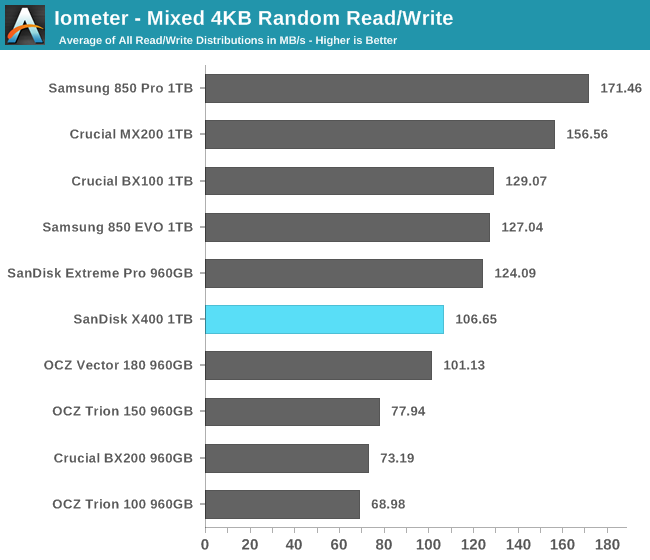
The mixed random I/O performance of the X400 is in the middle of the pack, slightly ahead of the MLC-based OCZ Vector 180 and significantly faster than the other three planar TLC drives.
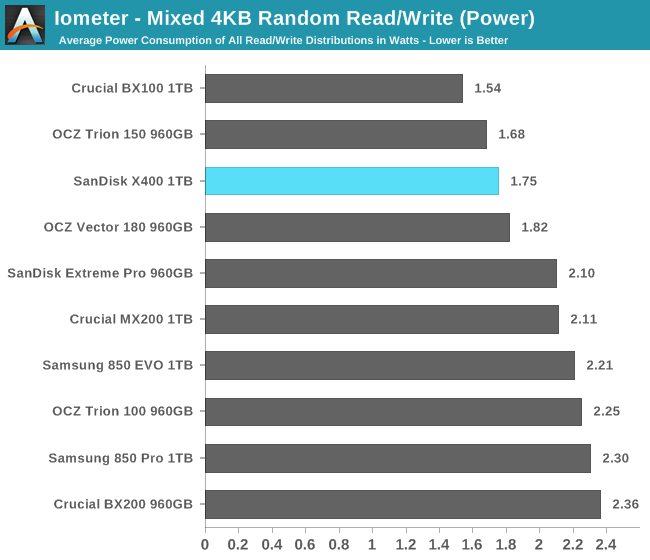
The X400 is once again the most power efficient planar TLC drive by a wide margin, and also ahead of a few of the MLC drives.
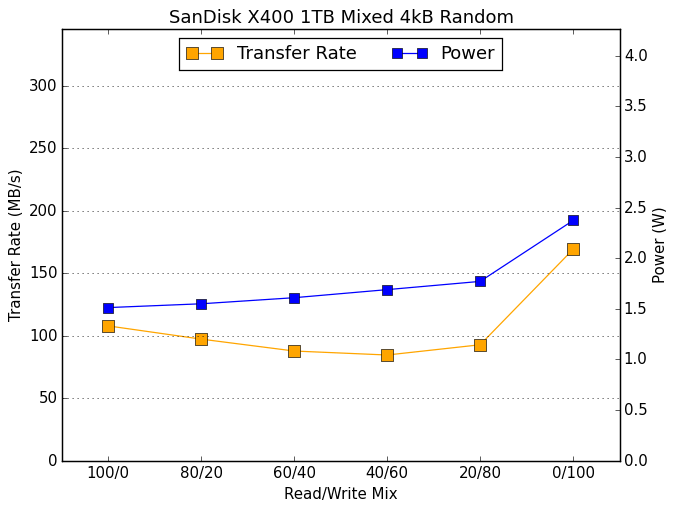 |
|||||||||
As the proportion of writes increases, the X400's power consumption grows quite slowly. Performance does suffer in the middle of the test and the spike at the end when the test shifts to pure writes is smaller than for the MLC drives and the 850 EVO.
Mixed Sequential Read/Write Performance
The mixed sequential access test covers the entire span of the drive and uses a queue depth of one. It starts with a pure read test and gradually increases the proportion of writes, finishing with pure writes. Each subtest lasts for 3 minutes, for a total test duration of 18 minutes. The drive is filled before the test starts.
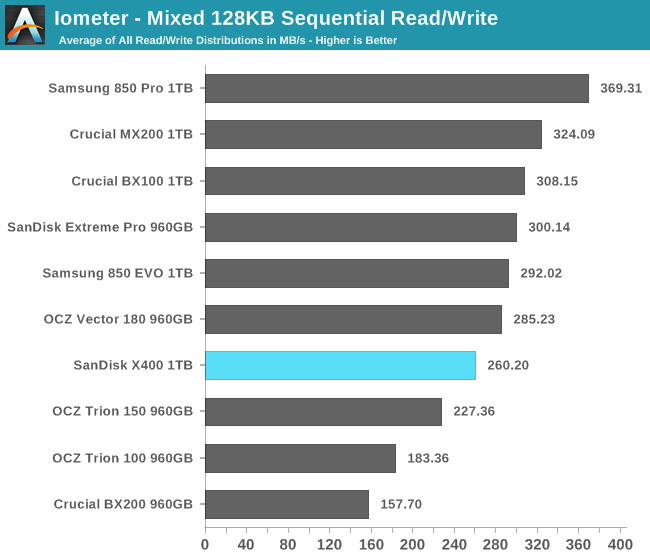
The mixed sequential I/O performance of the SanDisk X400 is not able to match any of the MLC drives, but is still comfortably ahead of the other planar TLC drives.
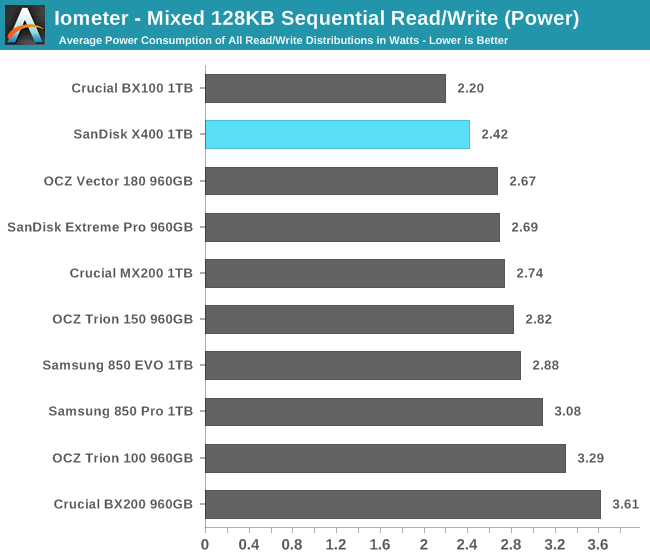
Average power consumption on the mixed sequential test is lower than everything other than the Crucial BX100, and the SanDisk X400 manages to tie the Vector 180 for efficiency, but otherwise it stands above only the other planar TLC drives.
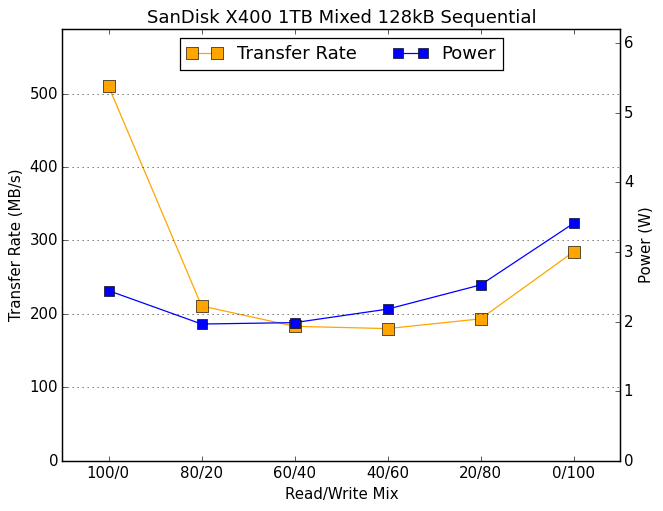 |
|||||||||
The performance and power curves for the SanDisk X400 are very similar to the SanDisk Extreme Pro except in the pure-write phase at the end of the test, where the X400's performance cannot come close to any of the MLC drives. The X400 beats the OCZ Trion 150 overall because its high read speed outweighs the write speed advantage of the Trion 150.










41 Comments
View All Comments
Chaitanya - Friday, May 6, 2016 - link
1TB capacity in M.2 Form factor is tempting.nathanddrews - Friday, May 6, 2016 - link
I like the $/GB, but there aren't enough GBs.Namisecond - Sunday, May 8, 2016 - link
Maybe you need to stop treating SSDs as bulk storage?dsumanik - Sunday, May 8, 2016 - link
Maybe you should go back to floppies.It's 2016 and there is no reason for magnetic drives to be alive. Yes yes, I know about cost per gig and all the stats you feel like googling and quoting to me to prove how smart you are, but the real truth is this: it's way more profitable to sell us 50 year old technology cuz dums dums will keep on buying.
Bring on xpoint, it'll help push traditional flash down into the bargain bin... And for u sir, Ii will gladly mail you my original dos 6.22 install disks if you simply shut the f**k up.
santeana - Monday, May 9, 2016 - link
LMAO! I wish there was a like button!+1
blakeatwork - Monday, May 9, 2016 - link
It's a process of how quickly do you need to access certain types of data. OS, programs and games all benefit from being on an SSD (assuming supporting architecture does not have any obvious bottlenecks). I'm not sure browsing photos from a recent vacation really provides the necessary strain on your I/O that requires an SSD :DMagnetic drives will stick around for quite a while, especially for Home/SMB NAS devices where the amount of storage is greater then the perceived need for super fast access, which is throttled by GbE network (or WiFi) anyways
bug77 - Tuesday, May 10, 2016 - link
Modern operating system do lots of stuff in the background, an AV may scan your drives from time to time. This is stuff that kills IO on a HDD and that barely registers on a SSD. So there are reason for moving away from HDDs... But yes, the HDD will stick around for a while, simply because of pricing.jordanclock - Saturday, July 2, 2016 - link
Good thing we just dump all old technology as soon as we find a replacement!edward1987 - Thursday, September 22, 2016 - link
1TB is quite out of my pocket £218 (http://www.span.com/product/SanDisk-X400-SSD-SD8SN... but 512GB I would not mind. If you have Qnap tvs-1282 server or similar - they have m.2 for caching or tiered storage. I can use for it in there.HollyDOL - Friday, May 6, 2016 - link
There is a mismatch in Specification table:1TiB (1024GB) should be 1TB(1000GB)
According to specs at https://www.sandisk.com/content/dam/sandisk-main/e...
putting 10^3n and 2^10n prefixes together is just incorrect anyway without correct recalculation...